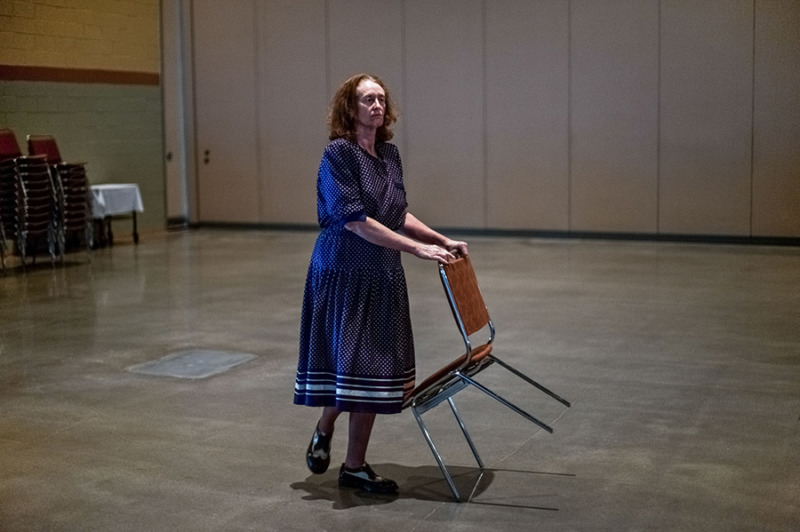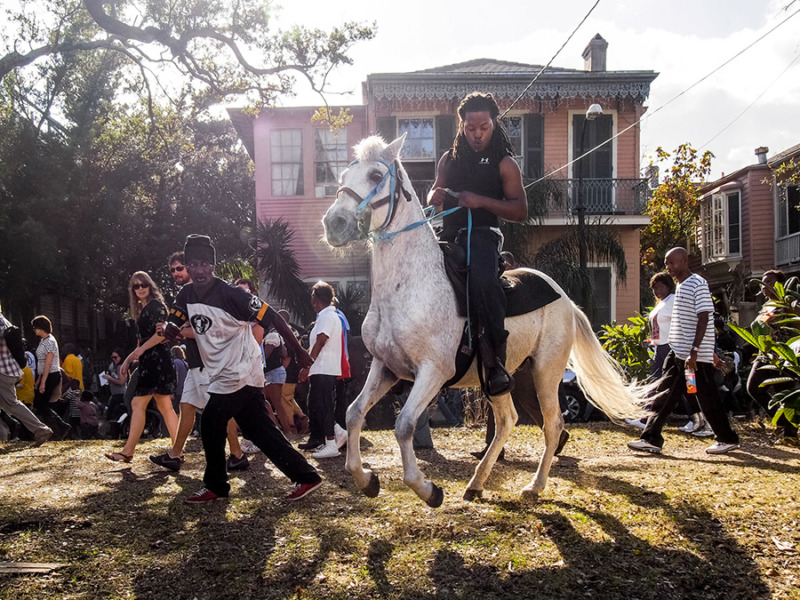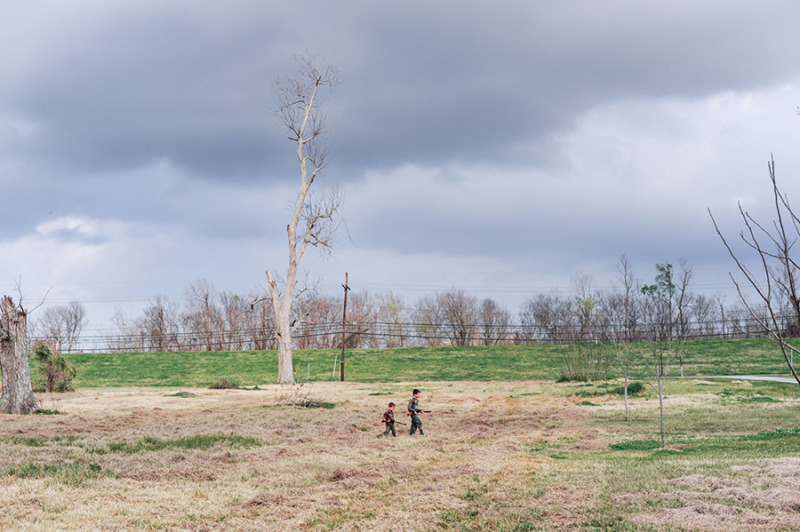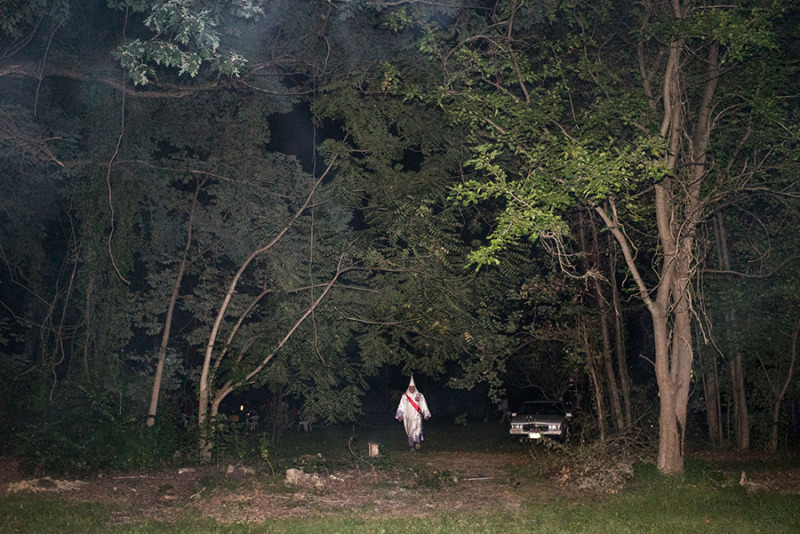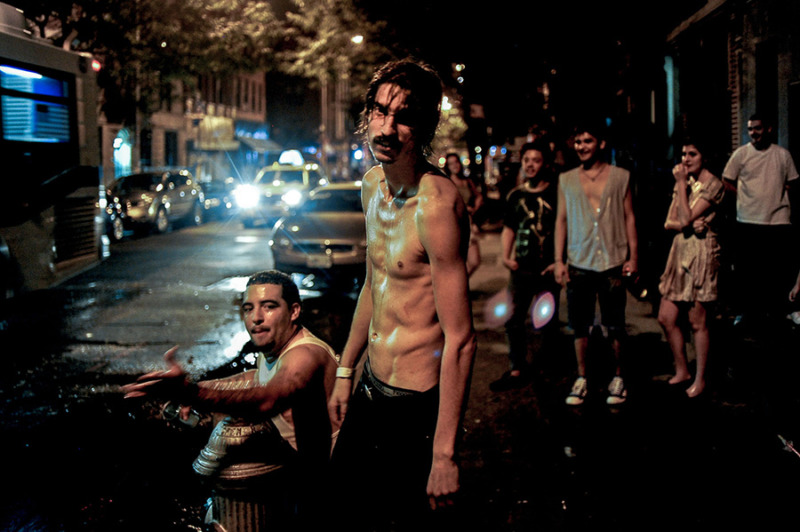Interview – Peter Van Agtmael

America’s coherence as a political entity tends to mask the greater divisions that exist within it, a national fracturing that, among other things, has cut off the centres of power from its troubled heartlands. Spanning the continent one might find many ‘countries’ that run uneasily in parallel, or at least many different ideas as to what constitutes the country. The fallout from trying to put these ideas into practice marks Peter van Agtmael’s new work Buzzing at the Sill, a wide-ranging collection of images made over a ten-year period. It continues the thread of van Agtmael’s previous two books following on from the invasion of Afghanistan and the war in Iraq after the terror attacks of September 11, 2001, which considered the destructive long-term impact of waging war as a means of overcoming division at home, attempting to create a consensus where none existed – or could exist, a war against some nebulous, but irredeemably ‘foreign’ enemy, seemingly without end, and the unsurprising failure of this policy, leaving only broken lives and bodies in its wake.
If previously van Agtmael was looking more directly at how those wars were being fought – and at what cost – here he is, once again, bringing the war home, often literally so, given the role that pictures of his own family play in the work. He doesn’t shy away from his personal fascination with warfare either, however difficult it has been for the people in his life to accept, a fact powerfully attested to in the anecdotes that van Agtmael inserts between the pictures. And although we don’t see almost any images that refer directly to it, the memory of those wars remains everywhere, producing echoes in otherwise innocuous situations. Violence has tainted everything; it is not only the actual fighting, but the damage that has spread out around it like a stain, so that a picture of someone tied to a fence after a bout of drunken high-jinks looks like a prisoner subjected to torture, and a woman wearing some kind of black cape with her arms playfully outspread can’t help but remind us of the hooded detainee photographed at Abu Ghraib. At the very least, our recognition of this willingness to let the end dictate the means reveals what was only ever a nominal war for ‘freedom’ as a shabby imperial power-play that cynically mobilised the deep public grief around a national tragedy.
So, even if nothing after them can ever be the same again for the people who fought in those wars or witnessed that fighting, like van Agtmael, this is also true for the country itself, having to confront the insuperable divisions that plague it. This awareness, now standing ominously at the threshold – or “buzzing at the sill” as the title has it – is the recognition of a greater conflict, in many ways twinned with the wars in Iraq and Afghanistan or at least brought about by the same forces, but happening on American soil and waged against its own citizens, a war about the very definition of America and who it might belong to, a domestic war of attrition carried out on the basis of class and race. But this is also a war of long duration, going right back to America’s founding as a nation, or even before. The way in which van Agtmael approaches these themes is not overt, in that he belongs to a generation of ostensibly ‘documentary’ photographers who favour ambiguity and nuance over simplistic moralising, but there is also no mistaking the angry, at times despairing tone of the work.
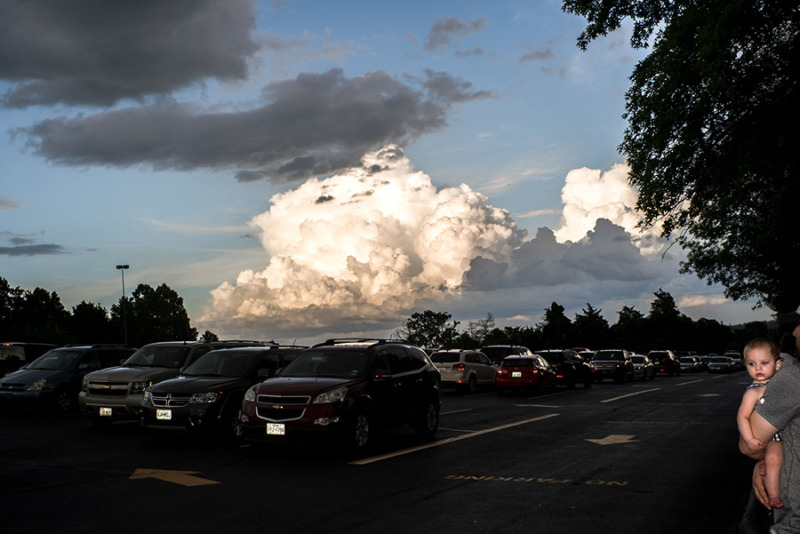
The brokenness of America’s conception of itself is painfully evident, then, shown as having deep roots and lingering consequences for the present. Native Americans are pictured living in difficult circumstances, the legacy of an historical betrayal, which the pictures obviously can’t encompass, but that the problems of the here and now make clear enough. The theft of tribal lands and the genocide that accompanied it assured American prosperity in an age of rapid expansion, leaving a whole set of peoples and cultures essentially destitute. Van Agtmael roots this legacy firmly in the present, one strand among many in a national tapestry that is increasingly frayed and threadbare, the social ‘fabric’ itself unravelling. Some of the most telling images in this respect were made on the Pine Ridge reservation in North Dakota. One shows a young man, a teenager really, in the headlights of a police car, as an officer menacingly points a Taser at him. The picture is made from inside the car, its point of view implicating both the photographer and the viewer in the scene that is unfolding. Ultimately, there seems to be no escaping the violence of the past.
Van Agtmael’s willingness to insert his own voice into the book is signally important here. He does this in the form of lengthy captions for each individual image, which appear at the end rather than beside the pictures, a well-considered choice, and also by placing longer autobiographical texts between the pictures, to anchor the progression of his work and to provide some background for it. The captions are significant in their own right, providing a context for the images that flesh out their visual impact with valuable details – knowing where and under what circumstances the pictures were made often enlarges their meaning, but locating them separately lets the images stand on their own as well, which most do. The longer texts reveal the photographer’s own motivations and experiences. We see especially the consequences for van Agtmael’s family of his pursuing an obsession with photographing war. He also details conflicting impulses and a strong awareness of his own ambiguous position as an observer of lives that are often very different from his own. This is something that crosses over into the captions as well, where in one case he talks about the strangeness of seeing himself portrayed in an article by Karl Ove Knausgaard, something van Agtmael realises is analogous to what he does with photography.
The cast of characters he draws on is a varied one, often resulting from chance encounters on his trips around the country or arising out of commissions. What we see, for the most part, is the diversity of American life, but also its divisions, the ever-widening gap between rich and poor, with the vanishing middle and the ideal of equality just two more causalities of progress. Everything tends to extremes. But in truth van Agtmael mostly concentrates on those with less, who are inevitably more exposed to the brunt of changing economic currents; even when he does show life ‘further up the scale’ it is always somehow off-kilter, a little hysterical and defensive, such as with the glaring crowd of drunken revellers after the Kentucky Derby or late-night beach partying at Art Basel in Miami. A sense of these vulnerabilities extends to his own family as well, where his father is shown buckling van Agtmael’s frail grandfather’s seatbelt or hanging sheets of plastic in their living room, implicitly preserving the state – and the values – of middle-class domesticity. It seems a world under threat.
Perhaps the most painful story in the book, though, is that of Shelly Hilliard, known as Treasure, a young trans woman brutally murdered by a drug dealer after she was forced to become an informant by police officers who found her in possession of an ounce of cannabis. Fearing she would have to serve a sentence in a male prison, she went along with a plan to entrap the dealer and was treated as utterly disposable by the officers responsible; the fact that African-Americans are far more likely to be imprisoned for minor drug offences is well known, as is the starkly disproportionate mortality-rate among trans people. Treasure was, in that sense, doubly vulnerable. Institutional prejudice and a culture of rampant misogyny led directly to her death. Van Agtmael can’t really show any of this, of course. Instead, he considers the effect on her family, who struggle not only with the tragedy, but with the blatant disadvantages of racial and economic inequality. We see them gathered together, while Treasure’s mother Lyniece cooks and the children play. That togetherness is sustaining, no doubt, but the odds are still decisively – and deliberately – against them. The spectre of race is an issue that runs through this work, a tangible, if often only implicit fracture, seemingly unhealable.
Van Agtmael portrays his native country, then, as the proverbial house divided, its founding traumas fundamentally inseparable from its successes. Many would consider this price too high, though apparently not everyone, given the sharply autocratic turn the country has recently taken. If nothing else, the pictures demonstrate the extent of those forces that had remained, until lately, just below the surface, but that were by no means unfelt; it is now hard not to view the work in terms of a world in which they are increasingly given free rein. Of course, disparity of wealth isn’t a new issue either, but the economic polarisation of American society brought about by policies of austerity intended to stem the world financial crisis has made its impact more widespread than ever. Historically, economic turmoil breeds fascism – and history, as we know, tends to repeat itself. This work is an eloquent statement of those ills America (and indeed the whole Western world) seem incapable of confronting, let alone curing. The last image of the book finds the remnants of van Agtmael’s own boyhood fascination with war scattered around his feet – as it is, in many ways, around ours as well.
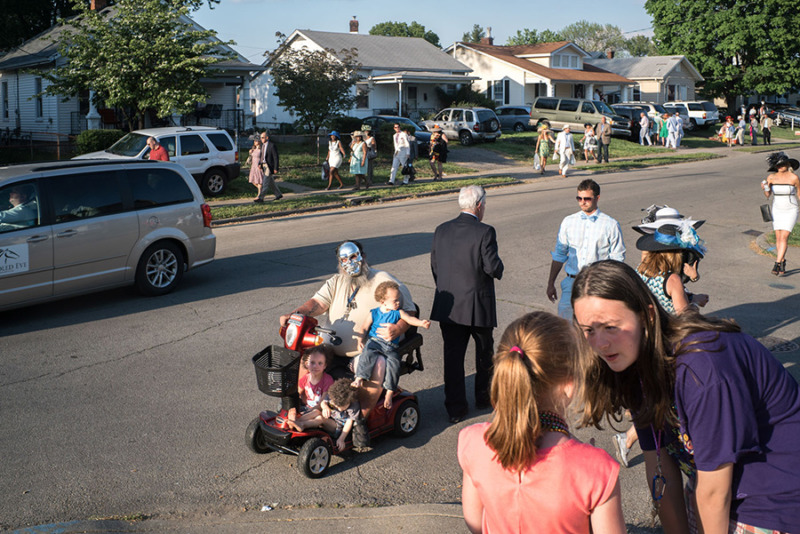
How did this body of work come about?
When I started Buzzing at the Sill, I’d been working intensely for several years in Iraq and Afghanistan. Though I was born and raised in the States, I’d grown up in a liberal North-East enclave that didn’t bear much resemblance to the communities that send a disproportionate number of young people into the military. I left the USA shortly after college and spent very little time there before starting to work in Iraq when I was 24. That first year in Iraq was a revelation. The intensity of the conflict seemed to dramatically sharpen my senses (while dulling certain emotions) and in the long months I spent living with American soldiers, I began to understand that I hardly knew my own country. Hanging out with a bunch of teenagers with overwhelming firepower and a largely undefined sense of what they were doing in Iraq was a contradiction so startling that I became very interested to understand how we’d arrived in such an insane situation. The military was a good place to begin understanding the margins of America, but it quickly became clear that I needed to explore the country in all its vastness.
As a consequence, then, this a very diverse collection of images made over a long period of time. How did you approach bringing them together?
I started very loosely, with several hundred 4×6 inch printouts. I began taking them to Magnum meetings and asking many different types of photographers to mark the images they liked. Their feedback gave me a general framework for what was resonating. From there I just kept shooting and slowly editing, making different sequences of different lengths in different formats. Slowly, over the course of about a year, the structure and design started to come together as I crystallized my own intentions and bounced the work off of a lot of different people, from my mom and partner to close friends, in and out of the photography world.
Can you say a little about the significance of the title?
The title is taken from a Theodore Roethke poem called “In a Dark Time.” I heard a line from it (“Which I is I?”) in a play called “The Nether,” and afterwards looked up the full text of the poem. I found it tremendously moving, for reasons I struggle to explain. I’m not much of a poetry reader, but it lingered in my memory for a long time and eventually I figured that it must have significance to this work. I generally try and trust what my subconscious is telling me. I felt that part of the poem should be the title, and I tried a number of different options until Buzzing at the Sill just stuck. David Alan Harvey and Alec Soth kindly helped in that process.
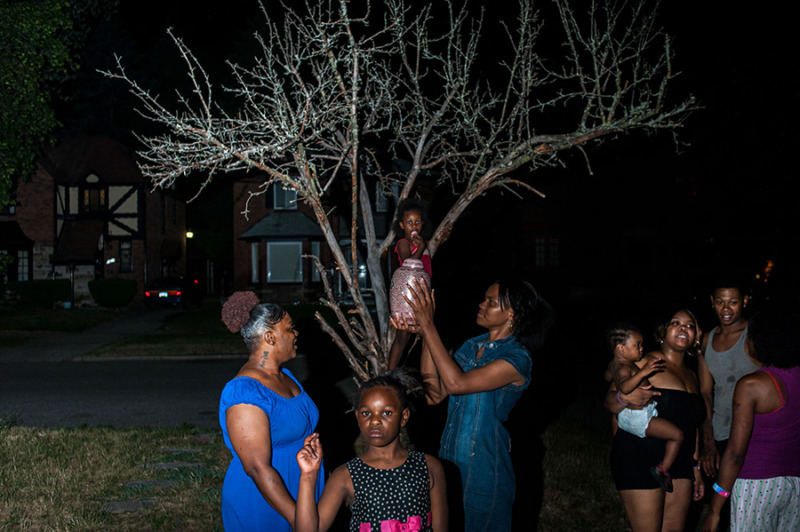
The role of text in the book is especially striking, both in terms of talking about your own experiences and the context you provide for the individual images. What prompted you to include these reflections?
Writing is a big part of my process. Photographs are a totally different language from writing, with very little overlap. I write because I want to be respectful of context and history, as well as from a desire to express some of the powerful moments I experienced that simply can’t be visualised as a photograph. Also, I enjoy it. It’s cathartic.
I don’t look at photography as a narrative device. It’s best at revealing all sorts of ghostly little fragments of the complexity of the world. It’s restrictive and completely open all at once. A big part of photography for me is recognizing its limitations, while trying to tap into its many layers of expression.
Was it difficult to re-examine your past experiences in this way, though, particularly in relation to combat situations?
To some degree. More difficult was writing Disco Night Sept 11, my previous book. I had a lot of troubling memories of my experience in war to come to terms with. Buzzing at the Sill was smoother. I just let my thoughts slowly drift out of my subconscious. I periodically wrote them into narratives. Some made it into the book while others sit in a Word document buried in my hard drive. Maybe they’ll be useful one day, it doesn’t really matter. It’s unclear to me why certain memories appeared when they did. Some I hadn’t thought about for decades. I’m always fascinated by that mysterious tension between the conscious and unconscious mind.
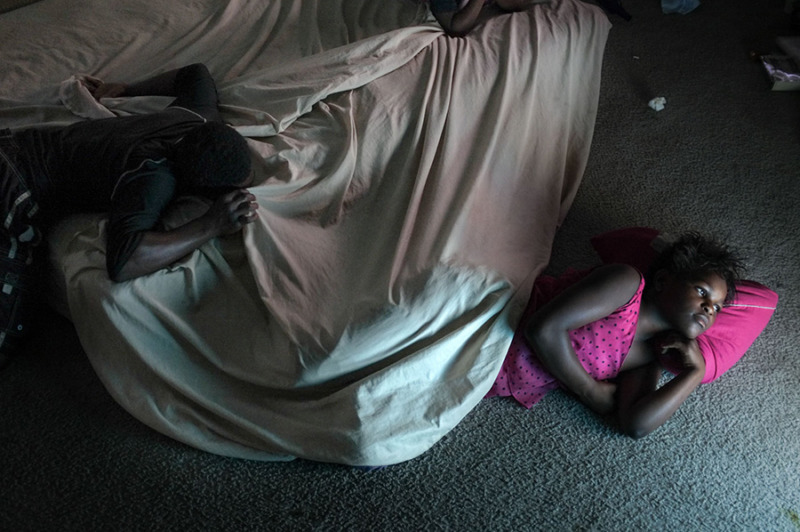
To what extent do you see the origins of America’s current political situation reflected in the pictures?
Our troubled history, and the isolation of the margins of America from the majority of the power and wealth of the country is a big part of this work. It’s important to note that these aren’t new forces. Almost all of these photos were shot during the Obama administration. They could have been shot at nearly anytime in the past half century.
Unsurprisingly, it doesn’t seem like you’re any more reconciled to the state of America than you might have been before, but do you think you understand it better now?
I don’t think it’s possible to reconcile with forces that are still so dramatically in motion. I’m content to just dig as deep as I’m able. I’m not looking to make peace with the place. I’m happy to be here and there’s a lot of work to do.
Your family also features quite prominently in the work. Why did you feel it was important to include these images?
I don’t look at photography as a narrative device. It’s best at revealing all sorts of ghostly little fragments of the complexity of the world. It’s restrictive and completely open all at once. A big part of photography for me is recognizing its limitations, while trying to tap into its many layers of expression. My family is a big part of my life, and as such needed to be a part of this book.
The book is also, in many ways, the summation of your own major concerns as a photographer. How do you see your work continuing in the future?
There are so many layers to this country and its history, I assume I could keep on going forever without running out of ideas. I have four book-length projects loosely planned out, with more to come I’m sure. It’s exciting and intimidating all at once.

